www.moonlandings.co.uk
Apollo 1 | Apollo 7 | Apollo 8 | Apollo 9 | Apollo 10 | Apollo 11 | Apollo 12 | Apollo 13 | Apollo 14 | Apollo 15 | Apollo 16 | Apollo 17 | Apollo 18 - Soyuz | Saturn V | Launch Complexes | Apollo Mission Summaries | Apollo Facts | Luna | Costs
Luna
Luna 9
Other Names: Lunik 9; 01954
Launch Date: 31 October 1966 11:45:00 UTC
On-orbit dry mass: 1580 kg
Description
The Luna 9 spacecraft was the first spacecraft to achieve a lunar soft landing and to transmit photographic data to Earth. The automatic lunar station that achieved the soft landing weighed 99 Kg. It was a hermetically sealed container with radio equipment, a program timing device, heat control systems, scientific apparatus, power sources and a television system. The Luna 9 payload was carried to Earth orbit by an A-2-E vehicle and then conveyed toward the Moon by a fourth stage rocket that separated itself from the payload. Flight apparatus separated from the payload shortly before Luna 9 landed. After landing in the Ocean of Storms on 3 February 1966, the four petals, which formed the spacecraft, opened outward and stabilised the spacecraft on the lunar surface. Spring-controlled antennas assumed operating positions, and the television camera rotatable mirror system, which operated by revolving and tilting, began a photographic survey of the lunar environment. Seven radio sessions, totaling 8 hours and 5 minutes, were transmitted as were three series of TV pictures. When assembled, the photographs provided a panoramic view of the nearby lunar surface. The pictures included views of nearby rocks and of the horizon 1.4 km away from the spacecraft.
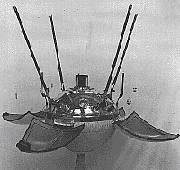
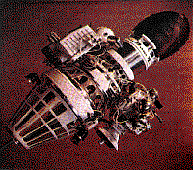
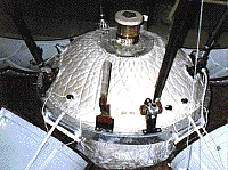
Luna 16
Launch Date: 12 September 1970 13:25:53 UT
Launch Site/Country: Tyuratam (Baikonur Cosmodrome), USSR
Launch Vehicle: Proton 8K82K/11S824 Booster Plus Upper Stage and Escape Stages
On-orbit dry mass: 5600 kgs.
Description
Luna 16 was launched toward the Moon from a preliminary earth orbit and entered a lunar orbit on 17 September1970 after one mid-course correction on 13 September. The lunar gravity was studied from this orbit, and then the spacecraft was fired into an elliptical orbit with a perilune of 15.1 km. The main braking engine was fired on 20 September, initiating the descent to the lunar surface. The main descent engine cut off at an altitude of 20 m and the landing jets cut off at 2 m height at a velocity less than 2.4 m/s, followed by vertical free-fall. At 05:18:00 UT, the spacecraft soft landed on the lunar surface in Mare Foecunditatis (the Sea of Fertility) Latitude 0.68 S, Longitude 56.30 E - as planned, approximately 100 km west of Webb crater. This was the first landing made in the dark on the Moon, as the Sun had set about 60 hours earlier.
According to the Bochum Radio Space Observatory in the Federal Republic of Germany, strong and good quality TV pictures were returned by the spacecraft. However, such pictures were not made available to the US by any sources so there is question as to the reliability of the Bochum report. The spacecraft was equipped with an extendable arm with a drilling rig for the collection of a lunar soil sample. It penetrated to a depth of 35 cm before encountering hard rock or large fragments of rock. The column of regolith in the drill tube was then transferred to the soil sample container
After 26 hours and 25 minutes on the lunar surface at 07:43:00 UT on 21 September, the ascent stage, with the hermetically sealed soil sample container left the lunar surface carrying 101 grams of collected material. The lower stage of Luna 16 remained on the lunar surface and continued transmission of lunar temperature and radiation data. The Luna 16 re-entry capsule returned directly to Earth without any mid-course corrections, made a ballistic entry into the Earth's atmosphere on 24 September and deployed parachutes. The capsule landed approximately 80 km SE of the city of Dzhezkazgan in Kazakhstan at 03:26:00 UT.
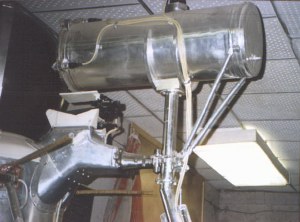 Left: The Luna 16 drill
Left: The Luna 16 drillBelow: Sample return capsules from Luna 16, 20 and 24
on display at the NPO Lavochkin Museum
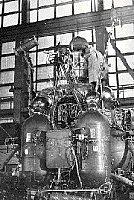 Luna 16
Luna 16 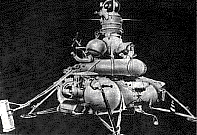
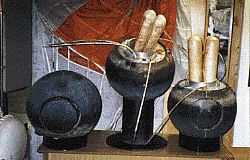
Luna 16 was the first robotic probe to land on the Moon and return a sample to Earth and represented the first lunar sample return mission by the Soviet Union and the third overall, following the Apollo 11 and 12 missions. The spacecraft consisted of two attached stages, an ascent stage mounted on top of a descent stage. The descent stage was a cylindrical body with four protruding landing legs, fuel tanks, a landing radar, and a dual descent engine complex. A main descent engine was used to slow the craft until it reached a cutoff point which was determined by the onboard computer based on altitude and velocity. After cutoff a bank of lower thrust jets was used for the final landing. The descent stage also acted as a launch pad for the ascent stage. The ascent stage was a smaller cylinder with a rounded top. It carried a cylindrical hermetically sealed soil sample container inside a re-entry capsule. The spacecraft descent stage was equipped with a television camera, radiation and temperature monitors, telecommunications equipment, and an extendable arm with a drilling rig for the collection of a lunar soil sample.
Luna 20
Launch Date: 14 February 1972 03:27:59 UTC
Launch Site/Country: Tyuratam (Baikonur Cosmodrome), USSR
Launch Vehicle: Proton 8K82K/11S824 Booster Plus Upper Stage and Escape Stages
On-orbit dry mass: 5600 kgs.
Description
Luna 20 was placed in an intermediate Earth parking orbit and, from this orbit, was sent towards the Moon. It entered lunar orbit on 18 February 1972. On 21 February 1972, Luna 20 soft landed on the Moon in the mountainous area named Apollonius highlands near Mare Foecunditatis (Sea of Fertility) at 19:19:00 GMT, Latitude 3.57 N, Longitude 56.50 E - 120 kilometres from where Luna 16 had impacted. While on the lunar surface, the panoramic television system was operated. Lunar samples were obtained by means of an extendable drilling apparatus. Luna 20 was launched from the lunar surface on 22 February1972 carrying 30 grams of collected lunar samples in a sealed capsule, and landed in the Soviet Union on 25 February 1972. The lunar samples were recovered the following day.
Luna 20 after its return to Earth 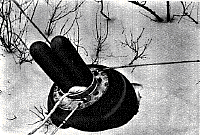

TV Imaging
The Luna 20 TV photography experiment used two special panoramic optico-mechanical TV cameras of the type used on the Lunokhod 1 Moon Rover in 1971. The cameras were placed on the landing stage under the module that returned to earth. They were positioned so that they were able to make circular scans of the area with a viewing angle of 30 degrees. To determine the position of the spacecraft relative to the meridian of the landing site, a panoramic picture containing an image of the Earth was obtained. All operations of the drill experiment were photographed by the optico-mechanical TV cameras.
Drill
The Luna 20 drill was a thin-walled tube carrying helical threads on its outside surface and a crown on sharp teeth at its cutting end. The drill was equipped with two special mechanisms, one for capturing hard core samples and the other for holding loose material. It operated at 500 rpm, and it took 30 minutes for the entire length of the drill to penetrate any kind of soil. The drill was provided with thermal insulation and was hermetically sealed to avoid the sticking together of metallic surfaces in contact and the adhesion of lunar soil to it. It was opened only before drilling. This made it possible to lubricate working mechanisims during drilling by oil vapour, ie a substance that evaporates in a vacuum. Certain parts were covered with a lubricant that lowered friction in a vacuum. The rod was first put in a vertical position, and then was slowly moved counterclockwise through a 180-degree angle. It was then lowered to the surface. If progress was stopped, a standby motor was employed to overcome the obstacle. The drill penetrated to a depth of 250 millimeters in the lunar surface, and its contents were returned to earth on 25 February 1972. The sample was placed in a special ampule and was hermetically sealed on the Moon.
Luna 24
On-orbit dry mass: 5600 kgs.
The last of the Luna series of spacecraft, the mission of the Luna 24 probe was the third Soviet mission to retrieve lunar ground samples (the first two were returned by Luna 16 and 20). The probe landed in the area known as Mare Crisium (Sea of Crisis). The mission successfully returned 170 grams of lunar samples to the Earth on 22 August 1976
 Luna 24
Luna 24 